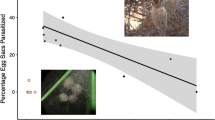Abstract
We report on spatial patterns of parasitism of oothecae (egg cases) of praying mantises (Stagmomantis limbata) by torymid wasps, Podagrion spp. Using collections of mapped mantid oothecae from Riparian sites in the Sonoran desert and Grassland sites in the Chiricahua Mountains (both in Arizona, USA), we characterized the spatial distributions of oothecae and parasitism. The likelihood of an egg case suffering some parasitism was higher at Grassland sites, which had high oothecal densities, than at low-density Riparian sites. However, experimental isolation of Grassland oothecae to densities comparable to Riparian sites reduced parasitism rates. At Riparian sites, parasitized oothecae exhibited on average the same extent of parasitism as parasitized oothecae at high densities but with much greater variation. Indeed, large fractions of Riparian oothecae suffered both severe (>50%) and light (<20%) parasitism, whereas most parasitized Grassland oothecae suffered intermediate levels of parasitism. Analysis of first nearest neighbor distances indicated that the parasite load of an ootheca did not depend on its immediate isolation. However, extending the analysis to include subsequent nearest neighbors (using a technique from spatial statistics called the R(K) function), we found that even though oothecae of S. limbata were spatially clustered, some oothecae in a (statistically defined) cluster escaped parasitism when overall oothecal densities were low. This pattern suggests that when oothecae are sparsely distributed, Podagrion wasps exploit only a fraction of the oothecae available locally, even though the oothecae are strongly aggregated relative to their overall density. We suggest this lack of congruency in the scales of oothecal deposition and parasitism at low densities (which is absent when oothecae are at high densities) may be explained in part by behavioral aspects of the parasite's reproduction, including increased host fidelity by relatively sedentary female parasites.
Similar content being viewed by others
Author information
Authors and Affiliations
Additional information
Received: June 13, 2000 / Accepted: October 16, 2000
Rights and permissions
About this article
Cite this article
Fagan, W., Folarin, A. Contrasting scales of oviposition and parasitism in praying mantids. Popul Ecol 43, 87–96 (2001). https://doi.org/10.1007/PL00012019
Issue Date:
DOI: https://doi.org/10.1007/PL00012019




